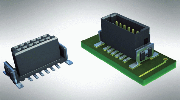 Flexible connector solutions are challenging traditional racking systems. Kevin Canham of HARTING explains
Flexible connector solutions are challenging traditional racking systems. Kevin Canham of HARTING explains
Today’s industrial devices and machines need to be extremely effective and powerful. Major control systems and networks are being increasingly equipped with back-up structures and controls. Machine status has to be analysed on site, and controls need to be directly accessible. On-site response times are speeding up; and automated control mechanisms such as camera inspection are increasingly accessing processes independently on a continuous basis – in real time, if possible.
In view of this situation, components and machines need to be equipped with increasingly intelligent and rapid control elements. Data-transfer rates within the device need to be as fast as those for the external receiver, particularly if functions such as image processing are involved. In addition, central control systems must be supplied with sufficient levels of data and information in order to operate properly in this context.
In addition, the overall system has to stand up to harsh industrial environments. Impact, vibration, dust and water are not allowed to have any influence on operational reliability – which obviously has significant repercussions on individual devices as well as overall machines and systems.
Systems also need to be user-friendly and easy to maintain. Today’s devices and machines are often configured in a modular fashion, and it must be possible to replace components quickly and easily. Any errors must be identified accurately as soon as they arise.
Decentralisation
The decentralised structure of modern facilities leads to significant benefits right from the design stage, and these developments also have a positive effect on costs: machines no longer have to be incorporated into the overall system for functional testing, and operational capability can be checked on a stand-alone basis.
This trend to increasing decentralisation has extended to industrial automation systems and larger production machines.
Larger components and machines are fitted with decentralised control elements that allow the activation of these directly on site and out in the field. Machine status enquiries, logs and analysis of error reports and damage correction are all diverted to the individual components or machines. This reduces the load on networks and central controls.
Consequently, components and machines need to be equipped with ever more intelligent control elements without reducing the demands of the industrial environment. Data-transfer rates also need to be stepped up in order to supply central controls with sufficient information and data for accurate facility and production control procedures.
 These trends are paralleled by a diverse range of developments in the components and subsystems that go into the industrial enclosure. Miniaturisation is a central factor: smaller and smaller chips with higher levels of performance make it possible to produce increasingly compact device designs. This results in the traditional design configurations being dispensed with: circuit boards are not only getting smaller, but the rigid layout of enclosures and their associated racking systems is also disappearing.
These trends are paralleled by a diverse range of developments in the components and subsystems that go into the industrial enclosure. Miniaturisation is a central factor: smaller and smaller chips with higher levels of performance make it possible to produce increasingly compact device designs. This results in the traditional design configurations being dispensed with: circuit boards are not only getting smaller, but the rigid layout of enclosures and their associated racking systems is also disappearing.
Industrial evolution
When industrial controllers were just being introduced, the focus was on freely available, non-specific connectors. Consequently, connectors according to DIN 41 612 form the foundation of the rack systems standardised in IEC 60297 that were in widespread use at that time.
In the second generation of systems, the product designers departed from these very open architectures: instead, in addition to a proprietary control unit, a backplane was used to provide the plug-in input/output capabilities.
In a further evolutionary step, the classic rack was replaced. The manufacturers created individual modules without plug-in frames, and these interconnected modules were plugged directly into a controller without a rack and backplane. The connectors to provide this facility were created in connection with specific solutions that were optimally adapted to the interconnection method and were implemented as an integral part of the automation modules.
Functional differentiation in these systems is achieved through the structure and composition of the devices within the enclosures. Built-in components, mainly in the connection technology sector, therefore need to be even more flexible, so that they can be inserted without changing the interfaces in any fundamental way. Hence a new approach to interconnection is evolving for the latest generation of industrial controllers.
These developments are reflected in the design of HARTING’s har-flex Mezzanine connectors, which are available in both straight and angled variants to provide a high degree of flexibility in their configuration to suit particular applications including switch cabinets and mobile devices.
The har-flex variant for ribbon cables makes it possible to create a wide range of board layouts within a housing: something that is particularly useful for devices involving human/machine interfaces such as displays, control panels and pushbuttons. Developers even have the freedom to produce new housing designs, as the previous layout and its rigid right angles no longer apply. All har-flex connectors can be freely combined and adapted to the housing.
In performance terms, har-flex connectors meet the requirements for the latest transfer protocols such as Gigabit Ethernet and PCI Express. Data transfer rates of up to 3.125 Gbit/s are easily achievable.
HARTING
T: 01604 827500
